Expert care tips for the blessed dart frog
The dart frogs of Central and South America are perhaps the most colorful and famous frogs in the world. Scientists classify these frogs within the family Dendrobatidae. The English name “dart frog” originates from the use of a few particularly toxic species in the making of blowgun darts by the native tribes of northeastern South America. Thankfully, few of these frogs are truly dangerous, and those that have been bred in captivity are completely harmless. Scientific evidence has shown that the wild frogs get their toxins from the food they eat in their natural habitat. In captivity, these foods are not available, and so the frogs pose no danger.
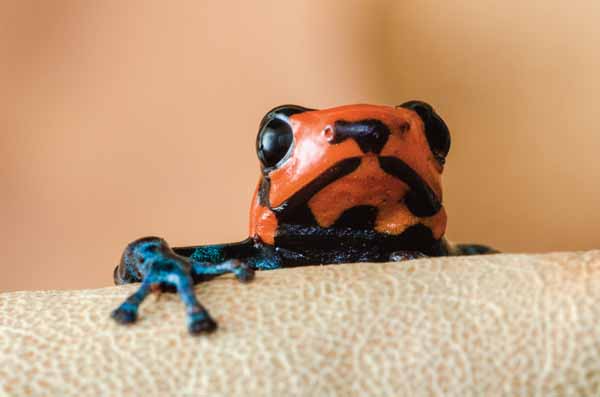
Photo by John Clare
The blessed dart frog is a small, mainly tree-dwelling frog from the Amazonian part of Peru.
The captive dart frog hobby has gained a lot of popularity in the past decade. This is quite a contrast to the 1980s and 1990s, when these frogs rarely made it into the hobby. Now the Internet is alive with discussion forums and care websites, and virtually every reptile show in the country has more than one table selling these fascinating jewels of the rain forest.
Their popularity is due, mainly, to three aspects of their behavior and biology. First, they are active by day (known as diurnal), unlike the vast majority of frogs, such as most tree frogs. Second, they are usually somewhat bold in comparison to other frogs because in the wild their toxins discourage other animals from eating them. Last, as a result of their toxins, they display bright warning colors (known as aposematic coloration).
These frogs may lack their toxins in captivity, but the stunning, bright warning colors that have made them so popular remain. And among the most brilliantly colored is the blessed dart frog (Ranitomeya benedicta).
The blessed dart frog is a small, mainly tree-dwelling frog from the Amazonian part of Peru and neighboring countries. This particular species was only described to science in 2008. Thanks to one of the scientists, Mark Pepper, who also runs a conservation-driven business called Understory Enterprises, captive specimens of the blessed dart frog have made their way legally into the U.S. frog-keeping hobby.
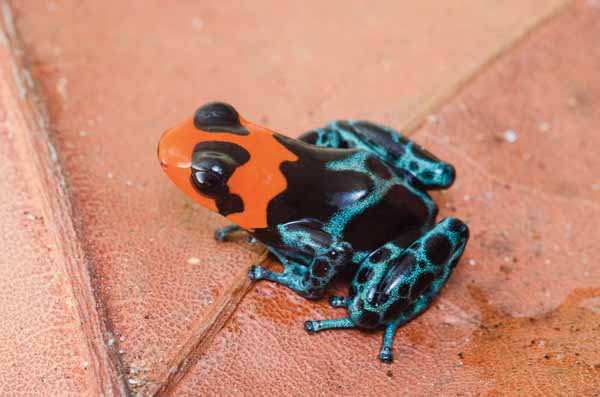
Photo by John Clare
In captivity, blessed dart frogs are very easy to spot because of their bright-red crowns.
In Peru, this frog is found in the warm rain forest of the Pampas del Sacramento, hence the choice of the frog’s species name, benedicta. Sacramento means sacred in Latin, and benedicta means blessed. Like its close relative, the imitating dart frog (R. imitator), it is small (less than an inch, not including the legs) and equipped with adhesive toe tips for climbing in the trees, where individuals spend most of their time. They make use of water trapped at the base of large-leafed plants and in old bamboo. There is no evidence that this species raises its tadpoles like the imitating dart frog—care ends for R. benedicta when the male deposits newly hatched tadpoles in individual bodies of water. Given that the parents do not feed their young as the imitating dart frog will, they deposit their tadpoles in larger bodies of water that can support algae and suitable tadpole prey.
In captivity, blessed dart frogs are very easy to spot because of their bright-red crowns. Boldness varies among specimens—youngsters are particularly nervous—but adult frogs kept in a well-planted terrarium are visible for much of the day. In fact, one of my males will sit out on a leaf in full view and call incessantly as I landscape a terrarium or feed frogs on a shelf above his.
For first-time Ranitomeya keepers, I generally recommend one of the boldest species, such as R. imitator (any race) or R. variabilis the “southern” race. But the blessed dart frog is a great second addition to a collection, and its bright-red coloration is definitely more vivid than any other Ranitomeya.
Acquisition
Thanks to the efforts of the Canadian conservation-driven company Understory Enterprises, U.S. specimens of this frog are entirely captive bred and of legal origin. The company actually uses its profits to fund frog conservation and habitat preservation.
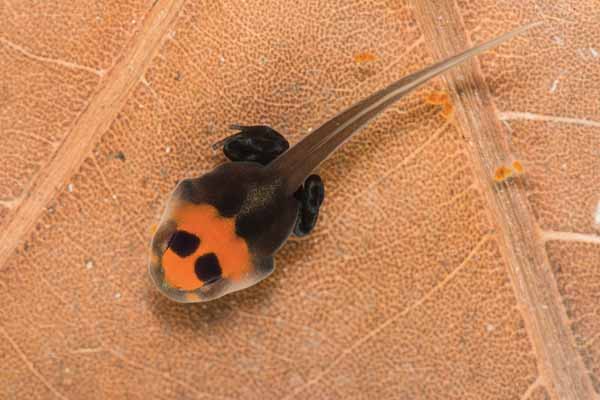
Photo by John Clare
U.S. specimens of this frog are entirely captive bred and of legal origin.
There are two races of blessed dart frog, each named for the location in which they were found. The first is known as the “Shucushuyacu” race, and it can be identified by the bright, pastel-blue reticulations over the black parts of the body and legs. A captive-bred individual of this race was fetching well in excess of $300 when first available a few years ago, but this race has been in captivity the longest, and many hobbyists have bred it in great numbers. It is not uncommon now to see them for sale by hobbyists on the Internet for $150 or less.
The second race, which was released into the hobby in the summer of 2012, is known as “Pampa Hermosa.” The name means “beautiful fields or grassy lowlands.” These differ from Shucushuyacu in that they completely lack the blue reticulations. Instead, they have a diffuser blue haze or they lack the blue coloration completely, resulting in a red and black frog. Unlike Shucushuyacu frogs, the Pampa Hermosa frogs are only just starting to breed in the U.S., so they are not available at reptile shows or from hobbyists yet.
These frogs are typically sold as well-started juveniles. When selecting a frog, look for bright, haze-free eyes. The frog’s body should not be noticeably thinner than the width of the head, and it should look alert. Males are generally smaller and thinner than females, but these differences are usually hard to discern in juveniles.
Dart Frog Care and Housing
The blessed dart frog is relatively heat-tolerant for a Ranitomeya species, but it will expire if kept in the mid-80s degrees Fahrenheit for more than a couple of hours. Even then, heat stress can lead to disease and a prolonged death. Likewise, if individuals are kept at temperatures below 60 degrees, they can die or suffer long-term health problems. There is little room for mistakes, so if you are new to keeping dart frogs, it is important to take care of this concern before you acquire any frogs. I have heard of hobbyists losing many thousands of dollars’ worth of frogs due to summer electrical problems or heating failures during the winter.
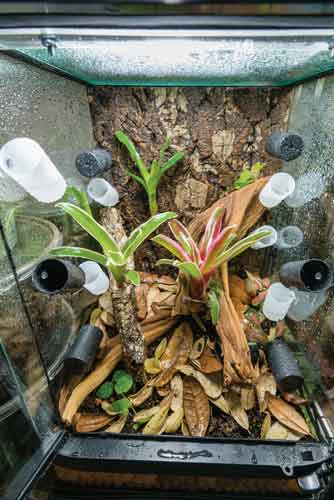
Photo by John Clare
Note all the plastic 35mm film canisters the author has placed in this dart frog terrarium, using suction cups. The frogs use them to hide in, and they also lay eggs in them.
Blessed dart frogs require similar temperatures to other dart frogs: 70 to 80 degrees during the day, with a slight drop at night (65 degrees should be considered a safe minimum). This is most readily achieved by housing the frogs in an air-conditioned room during the summer, but the room should be easy to heat in the winter. I use a small spare bedroom for my dart frogs, which has a door that I can close in the winter, so that a small portable electric heater can keep the temperature at a comfortable level. I also have a small propane-fueled camping heater in case of a winter emergency.
In-terrarium heating is an option, but it needs to be built into the terrarium’s design from day one. For example, I use a long, snaking heating cable buried in the substrate of a large display terrarium in my living room, controlled by a thermostat, to prevent winter temperatures cooling the terrarium below a safe level.
Ranitomeya are usually housed in terrariums that are taller than they are wide, known as “verts.” This type of terrarium is ideal for these climbing frogs. However, blessed dart frogs are lightning-fast jumpers, regularly jumping out of their terrariums when the doors are open for feeding. Therefore, most hobbyists house this species in a horizontal terrarium, such as a glass aquarium.
Blessed dart frogs are not as territorial as other Ranitomeya, and they will do well in groups, provided enough space is offered. For two pairs of these tiny frogs, a 20-gallon aquarium is suitable, but the larger the terrarium the better. It’s not possible to create a perfectly balanced ecosystem in such a tiny space. A larger terrarium will provide a more stable environment.
There are more expensive specialized glass terrariums available, but I typically house breeding groups of blessed dart frogs in cheap and readily available horizontal glass aquariums. It’s the hobbyist’s choice, but keep in mind that some terrariums and orientations allow for better viewing of the frogs.
Dart frogs require a stable environment, and one of the most important aspects is humidity. Unlike most other frogs, dart frogs tolerate limited ventilation of their terrarium, so maintaining high humidity (80-plus percent) is not difficult. Frog vendors sell conversion kits, which are hinged glass lids with insect-proof mesh over a small portion of the lid. You can make your own if you’re handy, but it’s usually cheaper and easier to purchase one. A good misting every two or three days using a hand mister sold for plants will keep things ticking over. Be sure to use distilled or reverse osmosis water to prevent mineral deposits on the glass.
Many dart frog enthusiasts choose to make a naturalistic background. This can be as simple as a panel of cork bark cut to fit the size of the terrarium, which is then fixed in place using aquarium silicone, or elaborate backgrounds made out of sculpted insulating foam and terrarium wood. There are many good examples to be seen in magazines and on the Internet. This can be one of the most satisfying parts of building a naturalistic terrarium for your frogs.
Now, starting from the bottom and working up, let’s go over the basics of furnishing a dart frog terrarium. Due to the high level of moisture in the terrarium, it’s important to have a drainage layer underneath any substrate to prevent water-logged substrate. If we don’t have drainage, the substrate can rot, releasing harmful gases and eliminating helpful microorganisms. A drainage layer at its simplest consists of expanded clay balls called LECA (light expanded clay aggregate), hydroton (a commercial alternative to LECA), or even a plastic grid known as “eggcrate” that is sold for industrial lighting fixtures, and that is propped up on some PVC pipe off-cuts.
The drainage layer should be at least 2 inches deep. Provided you don’t over-water the terrarium, you shouldn’t have to drain excess water, but I usually run a piece of PVC piping from the bottom of the drainage layer up past the substrate and cap it with a PVC cap. Every few months I can uncap the pipe and siphon any excess water remaining in the drainage layer using a piece of aquarium tubing. If you do this, be sure the frogs can’t get into the drainage layer or you’ll never get them out without taking the terrarium apart.
Cover the drainage layer with a piece of fiberglass window screen mesh to prevent substrate coming through.
There are several choices for substrate, but my personal favorites are Atlanta Botanical Gardens mix (ABG mix) or a homemade clay substrate. ABG mix is available commercially from frog vendors. It was originally developed for use with orchids by Ron Gagliardo of Amphibian Ark when he worked at the Atlanta Botanical Gardens. It has found great application in the dart frog world because it maintains a loose, well-ventilated consistency, while retaining just enough water. It lasts many years, and in a low-populated terrarium, it can conceivably last for the life of the frogs. Homemade clay substrate suitable for dart frogs is not commercially available, it’s relatively dense/heavy, and I wouldn’t recommend it to first timers.
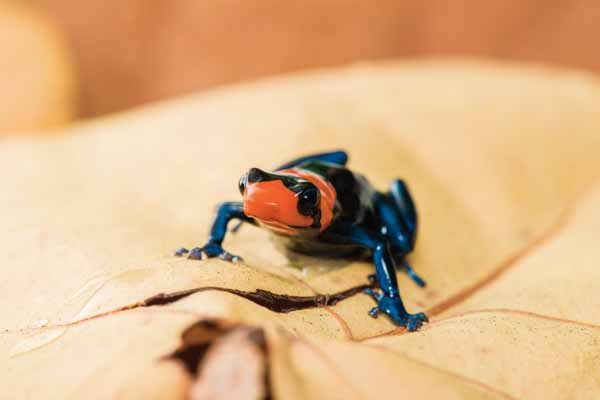
Photo by John Clare
Blessed dart frogs will do fine on the usual dart frog fare: wingless and/or flightless fruit flies. Don’t give them too many at once; you don’t want flies crawling all over your frogs.
The substrate of a dart frog terrarium is rarely changed out or cleaned. This is possible because microorganisms that live in the substrate will break down food and animal waste. Keeping the terrarium well-planted is important for this process, and introducing bugs, such as springtails (available from frog vendors), is also helpful. A nice, deep layer of substrate, say 2 to 4 inches or more, will ensure a healthy terrarium that will last a long time.
A layer of chemical-free leaf litter will provide refuge for your frogs and for helpful critters. Most hobbyists agree that their frogs are bolder when there is a good layer of leaf litter in the terrarium. Leaves from live oak (a species of tree), magnolia, pin oak, sea grape and Indian almond trees last a long time before rotting away. It’s best to avoid leaves from trees such as other oak species and maple because they rot very quickly. Again, supplies are available from frog vendors, or if you live in the south, southern magnolia trees are very common.
To break up the scenery, so to speak, and to provide climbing areas for the frogs, most hobbyists put interesting pieces of wood in their terrariums. Suitable types include ghostwood, manzanita, cork bark/cork tubes and Malaysian driftwood. Most other wood, including the grape wood sold for reptiles, will mold repeatedly and rot relatively quickly. Wood also provides good places to attach live plants.
Blessed dart frogs are often attracted to empty black plastic 35mm film canisters, both as hiding places and for laying eggs. I always include a few in the leaf litter and I use suction cups to stick a few to the sides of the terrarium, too.
Some hobbyists say that when we think we’re keeping dart frogs, we’re really keeping plants. There is some truth to this, given that the conditions for dart frogs are ideal for many plants. The mainstay of the dart frog terrarium is the bromeliad. These plants live on wood in the wild, getting their nutrients from the air (so called epiphytes—the air plants). Make sure to buy only small varieties because most are too large for all but the biggest terrariums. Dart frog hobbyists often have extras for sale, as do frog vendors. Bromeliads provide hiding places, pools of water and egg-laying/tadpoles sites.
Other suitable plants include Philodendron spp., creeping fig (Ficus sp.), Hoya spp., Dischidia spp., Pepperomia spp., Fittonia spp., some small ferns, and a surprisingly large number of small, shade-tolerant houseplants.
Lighting is essential to a planted dart frog terrarium. Luckily, we can find the materials at any reptile show or hardware store. For many of my terrariums, I use a dome fixture with a daylight spectrum bulb (anything with a color temperature between 5,000 and 1,000 Kelvin), both from any hardware store. I choose compact fluorescent bulbs due to lower power consumption, lower heat emission, and longer life than incandescent lights. There are more elaborate lights available from frog vendors, so take a look at your options.
I run my lights for 12 hours every day, 365 days per year. This approximates the light cycle found at tropical latitudes, and it’s easily accomplished using an electric timer switch that can be purchased at any hardware store.
Frog Food
The staple foods used by dart frog hobbyists are wingless and/or flightless fruit flies. These are not wild fruit flies, and they won’t fly around your house if they escape. The culturing of fruit flies is beyond the scope of this article, but the equipment (food, containers, etc.) and flies are available from frog vendors, along with instructions if you ask. Each week you start a new set of cultures, and after about two to three weeks they produce flies ready for your frogs.
There are different sizes of fruit fly available. I find that blessed dart frogs of all ages can consume the smaller species, Drosophila melanogaster, while only adults can tackle the larger species, D. hydei.
I feed my dart frogs every two days, with about 20 to 30 flies per frog. Don’t overfeed, because if the frogs don’t eat the flies in a few hours, the remaining flies could stress the frogs by climbing on them. Over time this could lead to the frogs getting sick and dying.
Fruit flies are not a complete food in and of themselves. They require supplementation. I dust with supplements at every feeding. This is my rotation over three feeding days and then it is repeated: calcium supplement the first feeding, a mixed vitamin/mineral supplement the second feeding, and vitamin A supplement on the third feeding. This ensures the frogs get a relatively balanced diet, keeping them in good health and allowing them to produce healthy and fast-growing offspring.
If you’re curious about dart frogs, the blessed dart frog is perhaps as striking as they come. With a little preparation and research you can comfortably keep and breed this rain forest gem for yourself.
John Clare, Ph.D., is the founder of caudata.org, the longest-running amphibian community on the Internet. He is also the founder of frogforum.net.


